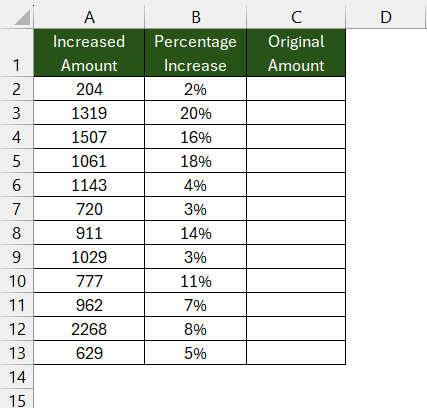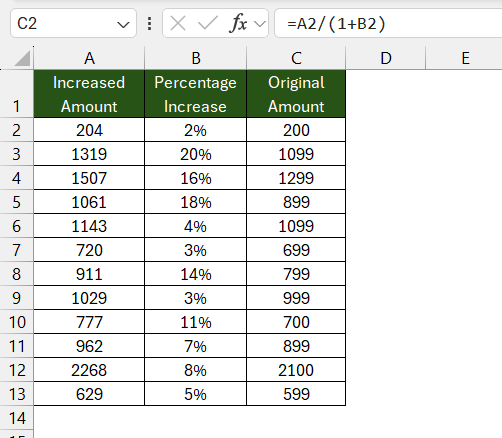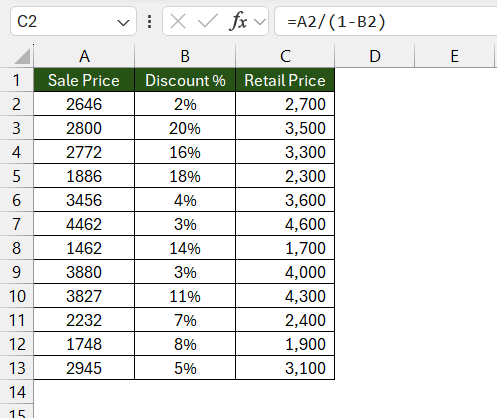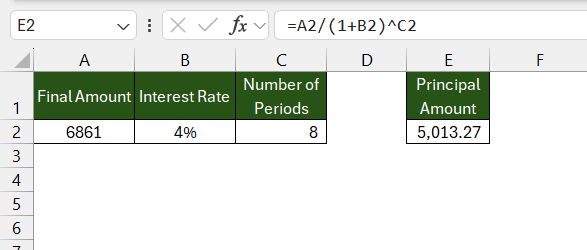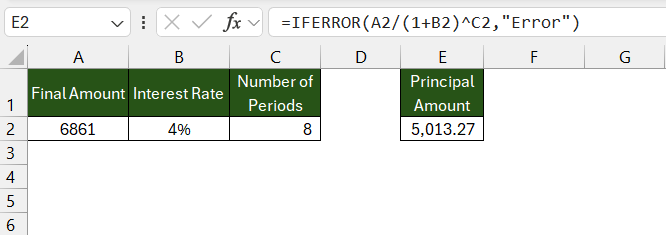

Key Takeaways:
- Reverse percentage calculator allows the calculation of original values before increases or decreases, invaluable in financial analysis, sales, and tax computations.
- Setting up a structured spreadsheet with labeled columns and entered data lays the groundwork for precise reverse percentage calculations in Excel.
- The formula for determining the original amount post-increase involves dividing the increased amount by (1 + percentage increase expressed as a decimal).
- To find the base value after a decrease, divide the decreased amount by (1 – percentage decrease expressed as a decimal), crucial for accurate budgeting and pricing strategies.
- Excel’s advanced features facilitate handling complex scenarios like compound interest and incorporate error-checking mechanisms to maintain the integrity of calculations, vital for robust financial modeling and analysis.
Table of Contents
Introduction to Reverse Percentage Calculator in Excel
The Importance of Understanding Reverse Calculations
Reverse percentages are a handy tool to backtrack and find the original quantities from given final amounts after percentage changes have occurred. This skill is crucial not just for mathematicians but for anyone dealing with financial data, discounts, markups, tax calculations, and similar scenarios.
How Excel Can Simplify Reverse Percentage Math
Harnessing the power of Microsoft Excel can transform the often-tedious task of reverse percentage calculations into a simple and efficient process. With Excel, you can automate the math, reduce the likelihood of errors, and achieve results with just a few keystrokes. Whether you’re dealing with financial analysis or wanting to figure out the original price before a discount, Excel’s versatile functions and formulas are there to assist you.
Setting Up Your Spreadsheet for Reverse Percentage Calculator
Entering Your Initial Data
To kickstart your reverse percentage calculations in Excel, the first step is to enter your initial data systematically. Begin by clearly labeling columns for the data you have, such as ‘Increased Amount’ and ‘Percentage Change’. Then, populate the rows with the respective values. By organizing your data methodically, you set a solid foundation for accurate and easy-to-follow calculations.
Determining the Original Amount After a Percentage Increase
To determine the original amount after a percentage increase in Excel, you need to divide the new, higher amount by the sum of 100% and the percentage increase, expressed as a decimal. For example, if an item’s price rises by 15%, the new price represents 115% of the original cost. Here’s the formula structure:
Make sure to convert the percentage increase to a decimal in the formula by dividing it by 100. This formula will reveal the original value before the price hike.
Finding the Base Value Following a Percentage Decrease
To reverse-engineer the original amount following a percentage decrease in Excel, the principle is similar to that of a percentage increase but with a key difference — this time, you subtract the percentage decrease from 100%. The adjusted formula reflects the ratio that the decreased amount represents of the original value. For instance, if a cost has been reduced by 20%, the new cost reflects 80% of the original amount. Your formula looks like this:
Don’t forget to express the percentage decrease as a decimal here as well, by dividing the percentage by 100. With this formula, the base value before the reduction will be calculated.
Advanced Techniques for Complex Scenarios
Dealing with Compound Interest and Reverse Percentages
Dealing with compound interest requires a more advanced approach to reverse percentages. To calculate the original principal amount before interest compounding, Excel can handle the formula involving exponents. Use the following structure:
In Excel, the caret symbol (^) denotes exponentiation. For example, if $2,261.47 is the amount after 3 years of annual compounding at 2.5%, the original deposit can be found by reversing the compounding using the above formula. Remember to input the interest rate as a decimal (0.025 for 2.5%).
This calculation can be especially helpful for complex financial analyses, such as understanding investment growth or loan interest over time.
Tips and Tricks for Excel Formula Efficiency
Avoiding Common Mistakes with Reverse Calculations
When performing reverse calculations, it’s crucial to sidestep common pitfalls that can lead to inaccurate results. Always remember:
- Do not simply subtract or add the given percentage to or from the final amount; instead, calculate in relation to the total (100%).
- For increases, divide the final amount by 1 plus the percentage (as a decimal). For decreases, divide by 1 minus the percentage.
- Be mindful of the base that your percentage operates on—to return to the original amount, always consider the full (100%) value.
By staying vigilant about these points, you can keep your reverse percentage calculations on the right track.
Implementing Error Checking in Your Formulas
In Excel, ensuring the accuracy of your calculations is paramount, particularly when handling complex reverse percentage formulas. To keep your data error-free:
- Utilize the
IFERRORfunction to catch and handle errors gracefully within your formulas. If an error is detected,IFERRORcan return a predefined response, such as “N/A” or “Error”.
- Employ Excel’s built-in ‘Error Checking’ feature, found under the ‘Formulas’ tab. This tool can help you identify common mistakes like incorrect arguments or broken formulas.
- Regularly review and audit your formulas by using the ‘Trace Precedents’ and ‘Trace Dependents’ functions to ensure calculations are based on the correct cells.
By applying these error-checking practices, you reduce the risk of unnoticed mistakes skewering your analysis.
Translating Reverse Percentage Skills into Real-World Applications
Case Studies: When to Use Reverse Percentage Calculations
Reverse percentage calculations are essential tools in various case studies across industries. For example:
Retail Pricing: Determining the original price of a product before a sale or discount is fundamental for profit analysis and inventory management.
Financial Analysis: In finance, reverse calculations help in figuring out the original investment amount after observing the total returns over a period, crucial for performance assessment.
By integrating reverse percentage formulas in such real-world scenarios, businesses can make more informed strategic decisions.
Applying Reverse Percentage Knowledge to Financial Modeling
In financial modeling, understanding reverse percentages is key to accurately infer original values from the final figures. Financial analysts routinely use this in:
- Budget Forecasting: Redefining base costs after accounting for expected percentage increases or decreases in expenses.
- Investment Analysis: Gleaning the initial investment needed to achieve a target return after a certain percentage of growth over time.
A command of reverse percentage formulas ensures that complex financial models are built on sound and clear assumptions.
FAQ: Mastering Reverse Percentages in Excel
What is a reverse percentage, and why do I need it?
A reverse percentage is a way to find the original number before a percentage increase or decrease was applied. You need it when you know the final amount and the percentage change and want to determine the original value. This is especially useful in figuring out pre-sale prices or the original budget before a financial change.
Can you provide an example of a reverse percentage decrease formula?
Certainly! For a reverse percentage decrease in Excel, use =B2/(1-A2), where B2 is the final amount after decrease, and A2 is the percentage decrease as a decimal. This reveals the initial amount before the deduction.
What tools within Excel can help visualize reverse percentage results?
In Excel, pie charts or bar graphs can help visualize reverse percentage results effectively. Utilize the ‘Insert’ tab to select a chart type, and then customize with labels, colors, and titles for better clarity and presentation of data.
How do I reverse a percentage in Excel?
To reverse a percentage in Excel, divide the final amount by the sum of 1 and the percentage increase, or the difference of 1 and the percentage decrease, converted into a decimal. Use the formula =B2/(1±A2) where B2 is the final amount and A2 is the percentage change in decimal form, ‘+’ for increase and ‘−’ for decrease.
What was the original price before the sale?
To find the original price before a sale in Excel, divide the sale price by 1 minus the decimal form of the sale percentage. For example, if an item is sold at $6800 after a 15% discount, the formula is $6800 / 0.85, resulting in the original price of $8000.
John Michaloudis is a former accountant and finance analyst at General Electric, a Microsoft MVP since 2020, an Amazon #1 bestselling author of 4 Microsoft Excel books and teacher of Microsoft Excel & Office over at his flagship MyExcelOnline Academy Online Course.

